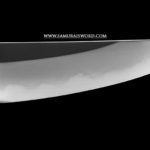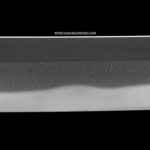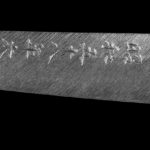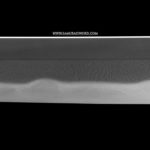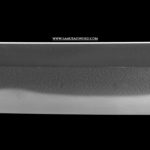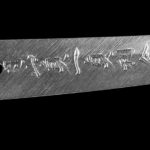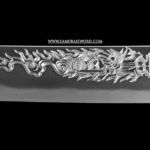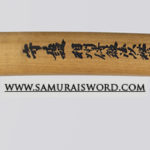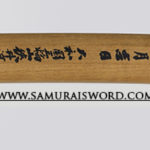Gallery Page (Display Only)
Description
A Gassan Sadaichi / Sadatoshi wakizashi
Father – Son Made!
w/ their excellent horimono & Sayagaki
Signed: Yamato no Kuni Ju Gassan Sadaichi Sadatoshi Gassaku (Kao)
Showa Go Ju hachi Nen Roku Gatsu Kichi Hi (Lucky Day on June, 1983)
Swordsmith: Gassan Sadaichi (1907-1995), Gassan Sadatoshi (1946-)
Period: Showa 58
Location: Yamato province
Approx measurements: Nagasa (cutting edge length): 54 cm; Motohaba (width): 3.57 cm
Shape: “Kanmuri otoshi” which is the style in which the shinogi is beveled in like a Naginata zukuri
H ada: ayasugi mokume mix
Hamon: very fine bright nie done in a gunome notare midare with Ashi, yo and fine kinsuji
Horimono: God of War Fudo Myoo, obverse is a very traditional suken done in kebori
Nakago: ubu, one mekugi-ana
Signature: Yamato no Kuni Ju Gassan Sadaichi Sadatoshi Gassaku (Kao)
Showa Go Ju hachi Nen Roku Gatsu Kichi Hi (Lucky Day on June, 1983)
Dated: June 1983
Ratings / Awards:
Gassan Sadaichi – In the 3 rd Shinsaku Meitôten , the sword forging competition held in 1967 by the NBTHK, in the course of which he received both the Masamune Award and the Bunkachô Chairman´s Award for his copy of the famous spear Nihongô (???). In 1970 received rank of mukansa and Intangible Cultural Property of Nara Prefecture. Juyo Mukei Bunkazai (Living National Treasure) in 1971. He received the Order of the Rising Sun 4th class in 1979
Gassan Sadatoshi – Mukansa status in 1982. Working at Sakurai city in Nara Pref he became intangible cultural property of Sakurai City, (Nara Prefecture) in 1997. In 2003 he became intangible cultural property of Nara Prefecture. Gassan Sadatoshi is in line to be designated National Treasure. Gassan Sadatoshi also went on to receive the Order of the Rising Sun 5th class in 2016
Saya-gaki:
?????????????????????????????
?????????????????????????????????????????
Shugo – S?sh?-den tanp? o motte hijutsu nagasa 1 shaku 7 sun 8 bu Fud?-sonz?, bonji, suken no kirimono.
Sh?wa goj?hachinen rokugatsu kichijitsu – Yamato no Kuni Miwayama Saigawa no hotori – okatana kaji-k? –Tai’a Gassan Minamoto Sadaichi d? Sadatoshi kin-gassaku + ka?.
For (divine) protection – Forged in the S?sh? tradition, blade length ~ 53.9 cm, engravings of the deity Fud?, of a bonji (Sanskrit character), and of a suken (stylized ritual sword).
On a lucky day in June of 1983 – This sword was carefully made together by the swordsmiths Tai’a Gassan Minamoto Sadaichi and Sadatoshi at the Saigawa near Mt. Miwa in Yamato province + ka?
Included: Original silk bag with stitched in writing.
“A very rare and outstanding blade by Gassan Sadaichi, the son of the famous Gassan Sadakatsu, who was the son of the most famous Gassan Sadakazu. Sadaichi took the name of his grandfather, and continued his fame by becoming a living national treasure. His skill, in both sword making as well as carving shows well in this blade. What makes this particular blade interesting and rare as well is the fact that it was jointly made with his son Gassan Sadatoshi. Swords by Living National treasure smiths are rarely offered for sale, and most people are not aware of their true inherit value. Sadaichi’s blades are actually very rare, as he did not make many blades after he received his top title. He devoted his time to making his blades very special and of top quality. He was born on November 8, 1907, and passed away on April 1, 1995. He received his title as the 2nd generation Sadaichi (Sadakazu) on 1966, and then was awarded the highest title possible of Juyo Mukei Bunkazai (Living National Treasure) in 1971.
This blade is really spectacular, done in the Soshu style of swordmaking. The wide body with the extended Okissaki matches well the Soshu den hamon. The blade shape is known as “Kanmuri otoshi” which is the style in which the shinogi is beveled in like a Naginata zukuri. The hamon is made up of very fine bright nie done in a gunome notare midare. Ashi, yo and fine kinsuji appear in the hamon. The grain pattern is outstanding as well, done in a ayasugi mokume mix, this hada is fantastic to look at! Chikei and fine ji nie appear all throughout the ji. One can easily tell that this is a masterpiece work by the 2 smiths. And, as if that was not enough, the carving is excellent done by one of the best carvers of the time. One side has the God of War Fudo Myoo deeply carved very expertly showing great skill and strength, and on the obverse is a very traditional suken done in kebori. In top Japanese polish (Living National Treasure blades usually are only polished by the best polishers). A sword of this quality rivals many of that done by older famous smiths and are hardly ever offered to the public for sale. In a top level shirasaya with a rare sayagaki by Sadaichi’s own hand stating that this blade was jointly made with his son, in a special method that is a secret Soshu tradition. This blade was made around 12 years after he received his title of Living National Treasure.” – Written by Mike Yamasaki.
Signature
Yamato no Kuni Ju Gassan Sadaichi Sadatoshi Gassaku (Kao)Showa Go Ju hachi Nen Roku Gatsu Kichi Hi (Lucky Day on June, 1983)
GASSAN SADAICHI
Posted on 2013/07/21 by/Courtesy of Markus Sesko (Author)
Sadaichi was born on 8 November 1907 in Ôsaka into the young but already established lineage of the revived Gassan school. His civilian first name was „Noboru“ (?). The Gassan reviver was his great-grandfather Sadayoshi (????, 1800?-1870) who had studied under the famous shinshintô smith and reviver of old traditions himself, Suishinshi Masahide (?????). In the fourth year of Tenpô (??, 1833) Sadayoshi had moved to Ôsaka where he founded his own school, namely as mentioned with reviving the Gassan school from which he derived. Incidentally, the Gassan school became extinct in the late kotô period and the first later descendant who reappears in the records is Sadayoshi´s father Sadachika (??, 1771-1851) who lived in Sasagawa (??) in the Nishimurayama district (????) of Dewa province, i.e. just right where his kotô ancestors were active. However, Sadachika´s family name was not yet „Gassan“ but „Okuyama“ (??). It was namely Sadayoshi who adopted it as family name for his lineage. Both Sadaichi´s father and grandfather, Sadakatsu (????, 1869-1943) and Sadakazu (????, 1836-1918) respectively, were noted swordsmiths.
 Picture 1: Gassan Sadaichi
Picture 1: Gassan Sadaichi
Sadaichi started his training as swordsmith when his grandfather Sadakazu died. He was then eleven years old and his father Sadakatsu introduced him not only into the Gassan, but also into the gokaden techniques. First he signed with the „Sadamitsu“ (??) and a sword with that mei was accepted ( nyûsen ) for an exhibition of the Ôsaka Art Association ( Ôsaka Bijutsu Kyôkai , ??????). In 1927, he and his father got a special order from Ise´s Shrine Bureau ( Jingû-jichô , ????), affiliated with the prewar Ministry of Home Affairs ( Naimushô , ???), to forge in the following three years 68 tachi and 43 hoko to be offered to the Ise Shrine at the 58 th Rebuilding Ceremony in 1933. In between, more precisely in 1929, he and his father forged Emperor Shôwa a so-called „ daigenshi-tô “ (????), the sword for him in his function as supreme commander of army and navy. Pictures of some genshi-tô (???, „marshal swords“) can be found here . Ten years later in 1939, he forged a tachi to support the 700 th anniversary of Emperor Gotoba´s death. There was an association founded for this anniversary which held also a sword exhibition. Sadaichi, back then still under the name „Sadamitsu“, was one of 25 smiths to contribute to this exhibition. An oshigata of this blade is seen in picture 2.
 Picture 2: tachi
, mei
: „Shinzen – Gotoba-tennô shichihyakunen-sai-hôsan shinsakutô-hônôkai „ (????????????????????) – „Shôwa jûyonnen sangatsu-kichijutsu – Gassan Sadamitsu kinsaku“ (????????????????)
Picture 2: tachi
, mei
: „Shinzen – Gotoba-tennô shichihyakunen-sai-hôsan shinsakutô-hônôkai „ (????????????????????) – „Shôwa jûyonnen sangatsu-kichijutsu – Gassan Sadamitsu kinsaku“ (????????????????)
In 1943, Sadaichi was 36 years old, the family and school moved from Ôsaka to the city of Kashihawa (??) in Nara Prefecture where they erected the Gassan Nihontô Tanren Dôjô (?????????). Shortly later his father died, namely on 24 December 1943. Sadaichi took over the family and became also responsible for the guntô forge affiliated to the Ôsaka Army Arsenal ( Ôsaka Rikugun Zôheishô , ???????). When the war ended two years later, he faced the same difficulties as his colleagues namely that for the time being, sword forging as prohibited. He was 38 years old and just in the prime of his life. The following year his third son Kiyoshi (?), the later Gassan Sadatoshi (????) was born. Things changed and started to improve with the foundation of the NBTHK in 1948. Only one year later namely he was already able to contribute four tachi to the next Ise Shrine Rebuilding Ceremony to be held in 1953. However, he received his now obligatory official licence as a swordsmith, issued by the Committee for the Protection of Historical Buildings and Monuments ( Bunkazai Hogo Iinkai , ????????) in 1954 when he was 47 years old. Two years later he changed his smith name from „Sadamitsu“ to „Takateru“ (??).
1965 was another important year for Sadaichi and the Gassan school. It was namely when he opened the new Gassan Nihontô Tanren Dôjô in 228.8 Chiwara (??) in the city of Sakurai (??) in Nara Prefecture, zip code 633-0073. It is only about 8 km to the northeast of Kashihara and lies in idyllic setting at the foot of Mt. Miwa. You can find pictures of the forge at the official Gassan site here . If you are in the region, don´t miss to visit the dôjô and its Gassan Kinen Kan (?????) museum. In the same year he took the name „Sadaichi“, in a ceremony at the close Ômiwa-jinja (????) to which he also presented a tachi in this course. Important for Sadaichi was the 3 rd Shinsaku Meitôten , the sword forging competition held in 1967 by the NBTHK, in the course of which he received both the Masamune Award and the Bunkachô Chairman´s Award for his copy of the famous spear Nihongô (???). He was already 60 years old at that time. In 1969 he made another copy, this time of the ancient so-called „Heishishôrin-ken“ (?????) which was intended to be a temple treasure of the Shingon sect Chikurin-ji (???) of Kôchi Prefecture.
Another important year for Sadaichi was 1970. He had received by then successively the highest prize of the sword forging completion, i.e. three times since 1967. For this he was rewarded with the rank of mukansa and Intangible Cultural Property of Nara Prefecture. Apart from that he became a juror for the sword forging competition and forged another tachi for the next Ise Shrine Rebuilding Ceremony to be held in 1973. Only one year later, in April 1971 and at the age of 64, he finally received the status of ningen-kokuhô , an honour which was accompanied by an exhibition of its own at the Mitsukoshi department store of Kobe. One year later the Yomiuri Shimbun held their „ Kyoshô-ten “ (???), the „Maestro Exhibition“ featuring exhibits by artists decorated with the Order of Culture, members of the Japan Art Academy, and ningen-kokuhô . Sadaichi was of course qualified and selected for this exhibition. In 1973 he held his own exhibition called „ Nihontô ni ikiru “ (???????) and an exhibition just for him was held at the Matsuzaka department store in Ueno, Tôkyô. In the same year he received the Medal of Honor on the Purple Ribbon ( Shiju-hôshô , ????), awarded by the Japanese government to individuals who have done meritorious deeds and also to those who have achieved excellence in their field of work.
In 1976 it was again time to make another copy of the aforementioned Heishishôrin-ken, namely together with another famous ancient sword of the Shitennô-ji (????) in Ôsaka, the so-called „Shichisei-ken“ (???). The copies were meant as offerings for the same shrine. In the same year the monument honouring the Gassan smiths on the grounds of the Yachi-Hachimangû (?????) in Yamagata Prefecture, i.e. at the birthplace of the school, was finished. Sadaichi forged for the ceremony together with his son Sadatoshi a tachi in front of the shrine. In 1978 he became chairman of the Zen Nihon Tôshôkai (??????), the swordsmith association of Japan, replacing Miyairi Yukihira (????). One year later the Marukatsu department store of Hokkaidô´s city of Asahigawa held another Gassan Sadaichi exhibition and he received the Order of the Rising Sun 4 th class ( kyokujitsu-sh?jush? , ?????). In 1980 Prince Takamatsu (???????, 1905-1987) visited his forge in Sakurai and he participated in the „ Nihon no kyoshô-ten “ (??????, „Japanese Masters“) exhibition held by the Takashimaya department store for their 150 th anniversary. The next year the Matsuzaka department store of Yamagata city held another Gassan Sadaichi exhibition and just one year later he participated in the „ Ningen Kokuhô “ exhibition of the Boston Museum of Fine Arts where he was invited to set up a forge and create a sword for the exhibition. Another Gassan Sadaichi exhibition was then held in 1983 at the Ôsaka Shinsaibashi branch of the Daimaru department store, whereat the latter initiated another one just one year later for Sadaichi´s 77 th birthday. In 1984 he forged again five tachi for the next Ise Shrine Rebuilding Ceremony to be held in 1993. The following year, Sadaichi offered a sword to the Gassan-jinja (????) where the school once originated. 1986 he became managing director of the NBTHK and advisor for the Zen Toshô Kai. In 1988 he went once more to Boston, namely for the Gassan exhibition held again by the Museum of Fine Arts. Two years later the art gallery of the Takashimaya department store Tôkyô held an exhibition for father and son Sadaichi and Sadatoshi. In the same year he forged a mamorigatana for Princess Akishino and a tachi on the occasion of the coronation of Emperor Akihito. In 1994 he forged a tachi for the 65 th Sumo yokozuna Takanohana (???) and the art gallery of the Shinsaibashi branch of the Daimaru department store held the „ Ningen-kokuhô Gassan Sadaichi and his School“ exhibition, one of the last big events in his life. He died in the following year, on 1 April 1995 at the age of 87.
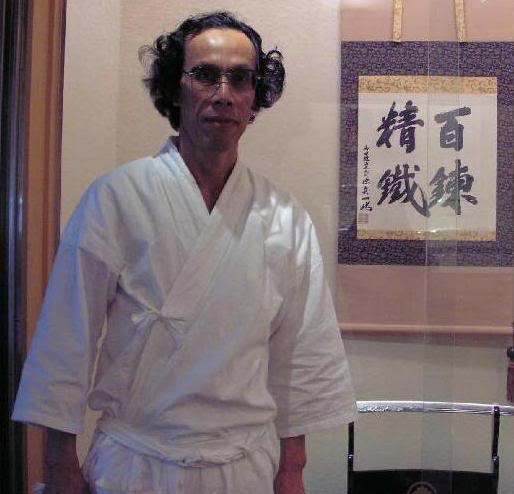 Gassan Sadatoshi (????)
Gassan Sadatoshi (????)
Civilian name, Gassan Kiyoshi, He was born in 1946 as a son of Living National Treasure “Gassan Sadaichi”. Gassan Sadatoshi achieved Mukansa status in 1982. Working at Sakurai city in Nara Pref. He became intangible cultual property of Sakurai City, (Nara Prefecture) in 1997. In 2003 he became intangible cultural property of Nara Prefecture. Gassan Sadatoshi is in line to be designated National Treasure. Gassan Sadaichi & Sadatoshi were/are both masters at horimono, like Gassan Sadakazu.

The Gassan school (?? )
The time-honoured kot? Gassan school was taken-up again in the shinshint? times by Sadachika (??). Sadachika, his civilian name was „kuyama Yasabur? (?????), was born in Meiwa eight (??, 1771) in Sasagawa (??) in the Nishimurayama district (????) of Dewa province. It is said that he was a descendant of the Gassan lineage and he died on the 19th day of the fifth month of Kaei four (??, 1851) at the age of 81. But the actual revival of the school has to be attributed to Sadachika´s son Gassan Yahachir?(?????) who adopted the name „Gassan” as his family name and who signed „Sada -yoshi” (??). Some old transmissions say that Sadayoshi was born in the first year of Tenmei (??, 1781) and died on the 19th day of the second month of Meiji three (1870) at the age of 90. But in Tenmei one his father Sadachika was only ten years old and so another transmission is much more likely, namely that he died in 1870, not at the age of 90 but 71. This, in turn, calculates his year of birth as Kansei two (??, 1800). However, Sadayoshi left Dewa in the early years of the Bunsei era (??, 1818-1830) and went to Edo to study under Suishinshi Masahide. After that, i.e. in Tenp?four (??, 1833), he moved to ?saka where he laid the foundation for the more recent success story of the Gassan school. We know blades from Sadayoshi from the Bunsei to the end of the Kei?era (??, 1865-1868). His jihada is the typical Gassan ayasugi , a masame in the Yamato tradition, or a dense mokume . The hamon is either a suguha in nie-deki , a small-dimensioned ch?ji-midare , or a koshi-no-hiraita midare . It is said that his adopted son Sadakazu made several daisaku-daimei works for him in his later years.
*Gassan School information: Courtesy – Markus Sesko (Author), E Nihon-shinshint?-shi (pages 124), Click to purchase
*Book page image: Courtesy – Markus Sesko (Author), E Genealogies and Schools of Japanese Swordsmiths (page 96), Click to purchase
Gallery
This Sword is not available for purchase.
If you wish to purchase a Japanese Sword please view our Nihonto for sale page or contact us directly via email or contact us at 1(608) 315-0083 any time, please include specifics of what you seek, i.e.: Katana, maker, era, price range etc.
Pictures and content may not be copied without the express permission of samuraisword.com ©









